How Do You Know if Youre Mining Ethereum
How to Mine Ethereum: NiceHash, Mining Pools, Optimal Settings
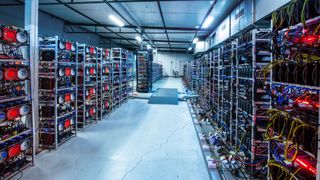
The cryptocurrency mining and
Ethereum miningnail has mostly tapered off, though even after twelve months, the rollercoaster ride continues. If you've read our
best mining GPUsand want to run across what all the fuss is about, we've got the details on the nearly popular ways of mining with your PC. Likewise the actual hardware for mining — which basically means having i of the
best graphics cards— you'll need to decide on the software you desire to run, and how you want to get paid. At that place are three chief approaches to mining, and nosotros'll cover these in club of ease of getting started.
Before we go on, let's be clear: Nosotros're all about providing information, both good and bad. In that location are GPU shortages, other PC component shortages, GPU prices are in the stratosphere, and clearly at that place are a bunch of people who think mining is awesome. This has all happened before, and we've seen how it ends — or at least where it goes temporarily. Anyone that had the foresight to put together a large mining farm two or 3 years ago so save all the Ethereum and/or Bitcoin it generated (while temporarily eating the costs) looks pretty smart today. At the same time, putting all the coin directly into buying cryptocurrencies would take gotten similar results with a lot less hassle.
But what if you lot're trying to do the same affair right at present? It will cost more, profits volition be lower (or not even materialize for potentially years, if always), and in that location are loads of other concerns that we'll get into.
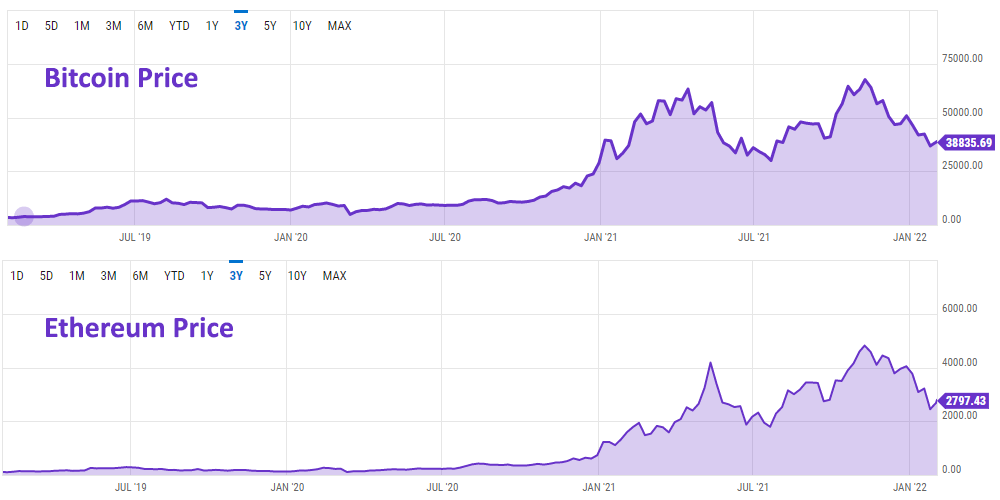
Case in signal: But look at the past 3 years. Nosotros originally posted this commodity with data taken from earlier Feb 16, 2021. Since that fourth dimension, we've seen tape prices for Bitcoin and Ethereum come and become, multiple times. The difficulty of mining has steadily increased, and potential profits take trended downward over fourth dimension. Currently, Bitcoin sits at around $38K and Ethereum is at $ii,700. That's about a 30–35% drib in value since early on December, 2021.
Longer-term stability tends to be at lower profit levels than what we saw in early 2021. Eventually, the difficulty of finding a block increases, or the price drops, either of which will drop the charge per unit of return, and miners stop putting lots of coin into scooping up GPUs. Ethereum difficulty initially peaked in May, so declined until late June (no doubt helped by Cathay'due south crackdown on mining), but has been on a steady upwardly climb since so and is nearly at 13,000 TH/s. Ethereum also has plans to shift to proof-of-stake (no more mining) in the start half of 2022, notwithstanding, and then GPU miners may before long have to expect elsewhere.
That brings us back to the matter at mitt. Lots of people nevertheless want to know about mining, how it works, and how much they can earn doing it. We'll answer those questions as best we're able, and bring up other concerns and related information that you might not have considered. Hopefully, past the end of it all, yous'll be better informed.
How to Mine with NiceHash
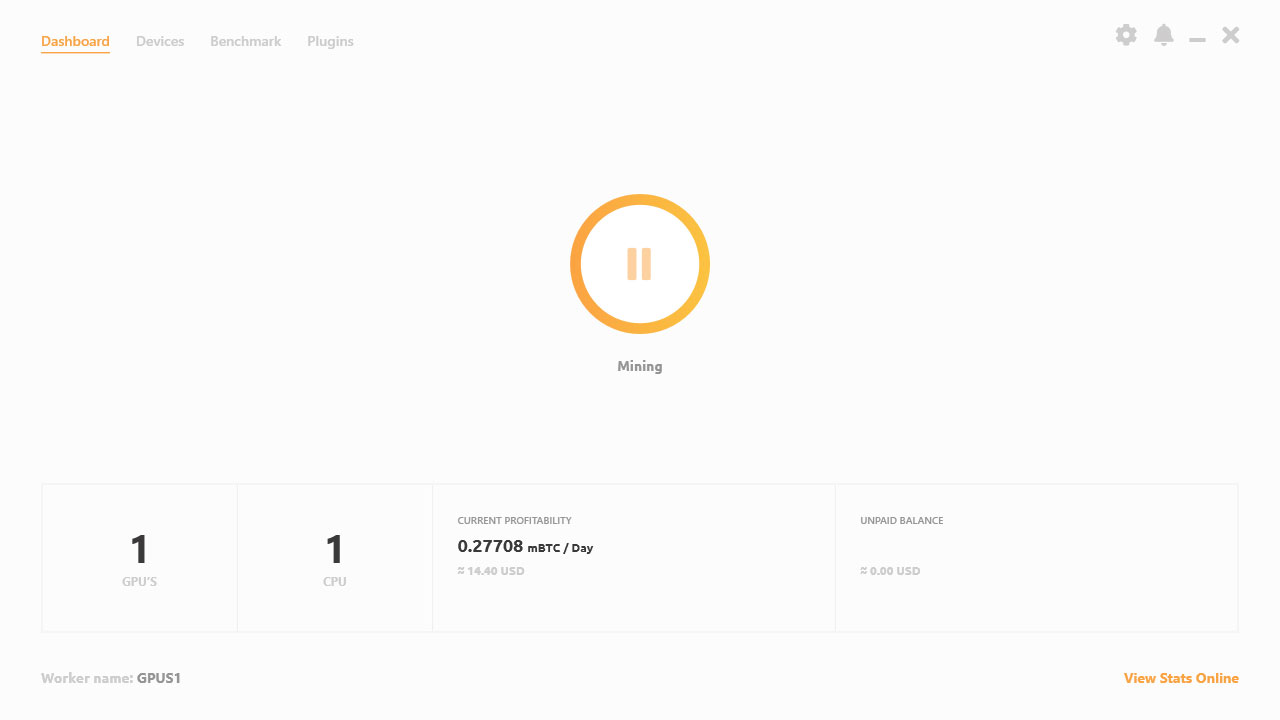
The easiest way to get started at mining is with NiceHash. NiceHash launched in 2014, right around the fourth dimension of the first major spike in cryptocoin mining (second if you want to include Bitcoin's initial "surge" to $32 per BTC in 2011). Prior to NiceHash, getting started with coin mining was more than complicated — as nosotros'll item beneath. NiceHash has greatly lowered the barrier to entry, and it gets rid of some of the worries about what money(s) to mine. You effectively lease your PC's hashing ability to other users, who get to choose what to mine, and you become paid in Bitcoin. NiceHash takes a small-scale cutting of the potential profits, and your PC can be upwards and mining in minutes.
(Notation: In that location are some alternatives to NiceHash, but generally speaking they function on similar principles. Some just mine the "most profitable" money at whatsoever given fourth dimension, and you proceed those coins (or fractions of a money). If a coin ends up becoming popular and shoots up in value, you could score big, but it can also go the other mode and you stop up with a bunch of worthless crypto.
We're non going to walk through every step of the procedure, as NiceHash already has multiple tutorials. The brusque summary is that you need to annals with the service, and yous should accept your own Bitcoin wallet somewhere (e.g. at
Coinbaseor another service). So you download the NiceHash mining software, configure it to mine to your BTC address (provided by NiceHash), and y'all're all set. Your BTC will accumulate on NiceHash, and you can transfer it out whenever y'all like — which is a proficient idea since you never know if or when another successful hack might occur.
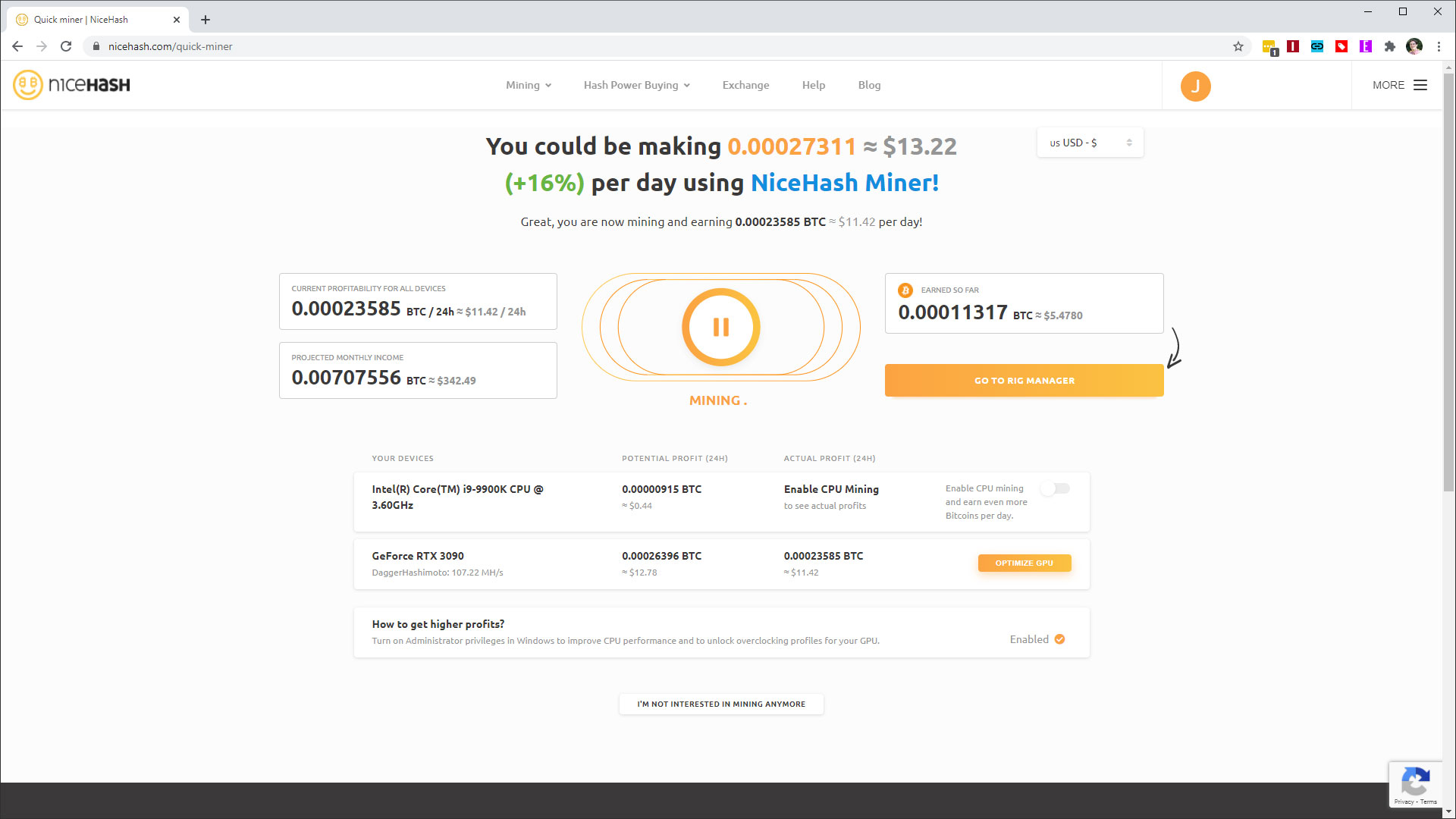
NiceHash has several options, ranging in degree of complexity. The easiest is to apply the new
QuickMiner, which is a web interface to a bones mining solution. You download the QuickMiner software, run that, and the webpage allows you to start and cease mining — you don't even demand to put in your BTC accost. Information technology's expressionless uncomplicated, though the numbers can fluctuate quite a bit. For example, in a cursory test QuickMiner suggested we "could be making sixteen% more" by using NiceHashMiner (which we'll go to side by side). Except, after letting both versions run for a scrap, QuickMiner seemed to stabilize at the same performance level as NiceHashMiner. YMMV.
Next up is
NiceHash Miner, which is what nearly people will want to use. Information technology'south more than complex in some means than QuickMiner, but it has more than options that can improve overall profitability. By default, it volition enquire y'all to log in using your NiceHash account details. Alternatively, you tin utilize the NiceHash app on your phone to browse a QR code, or but input your BTC address manually.
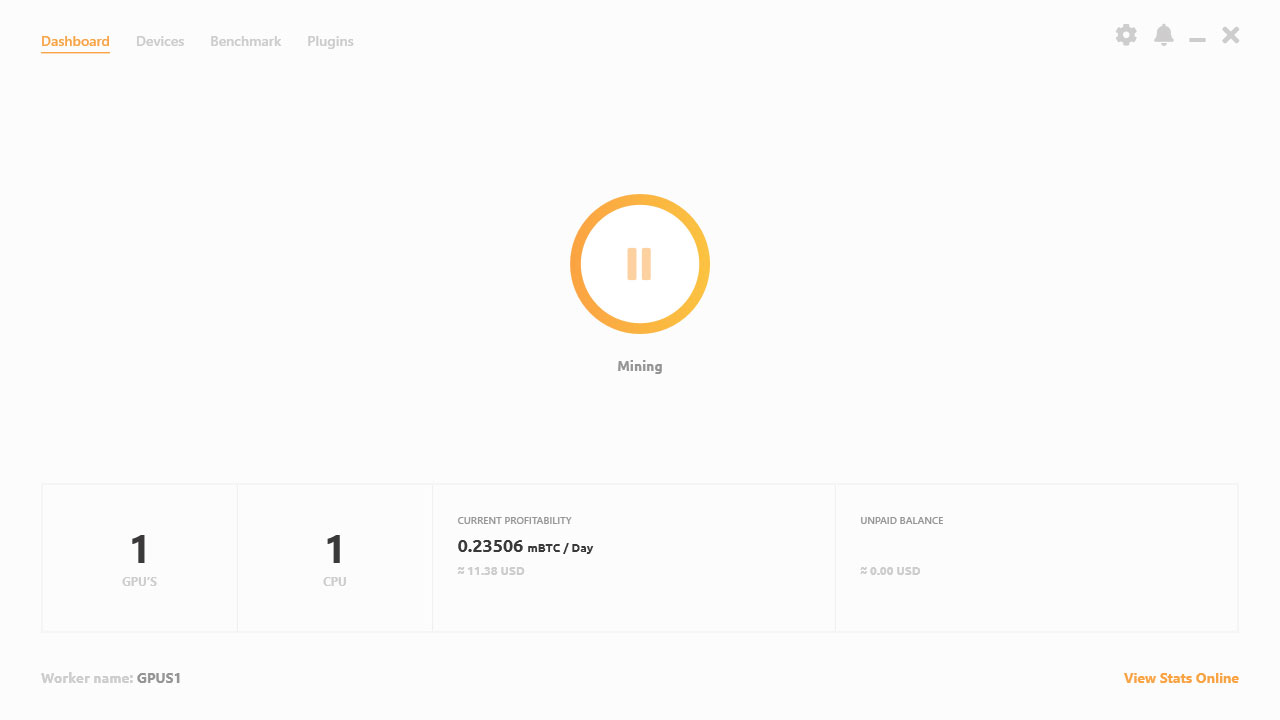
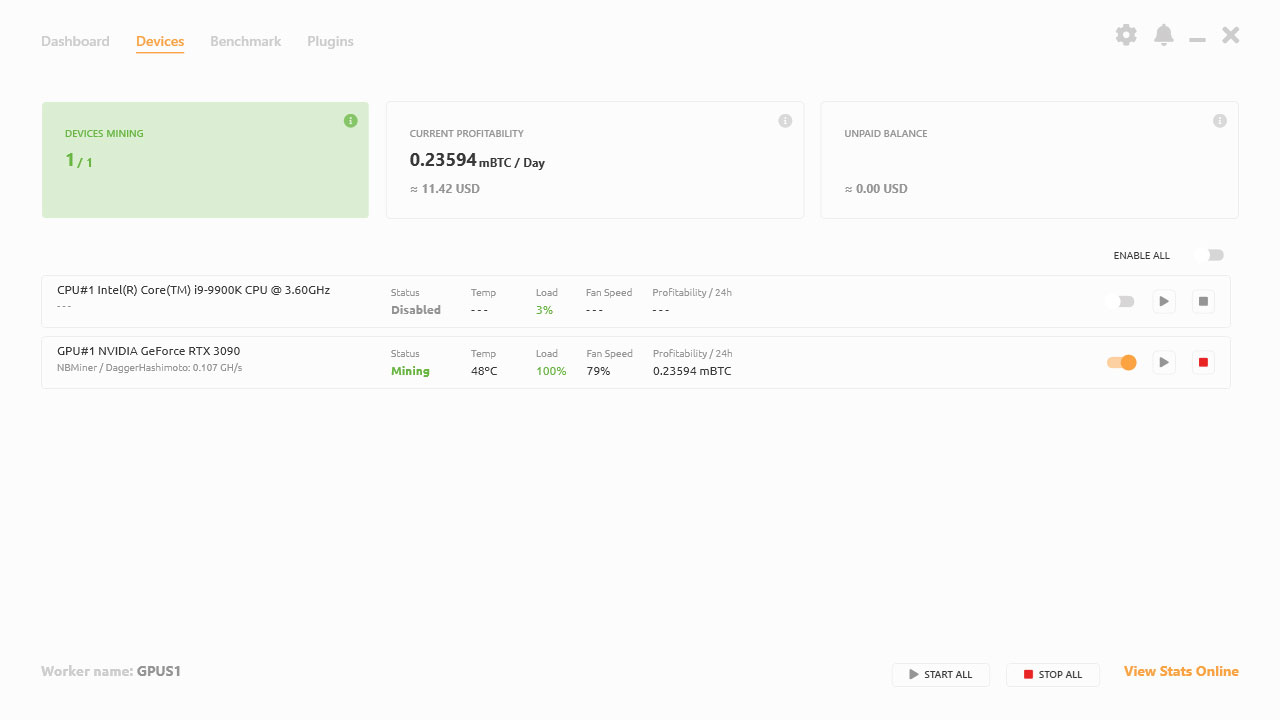
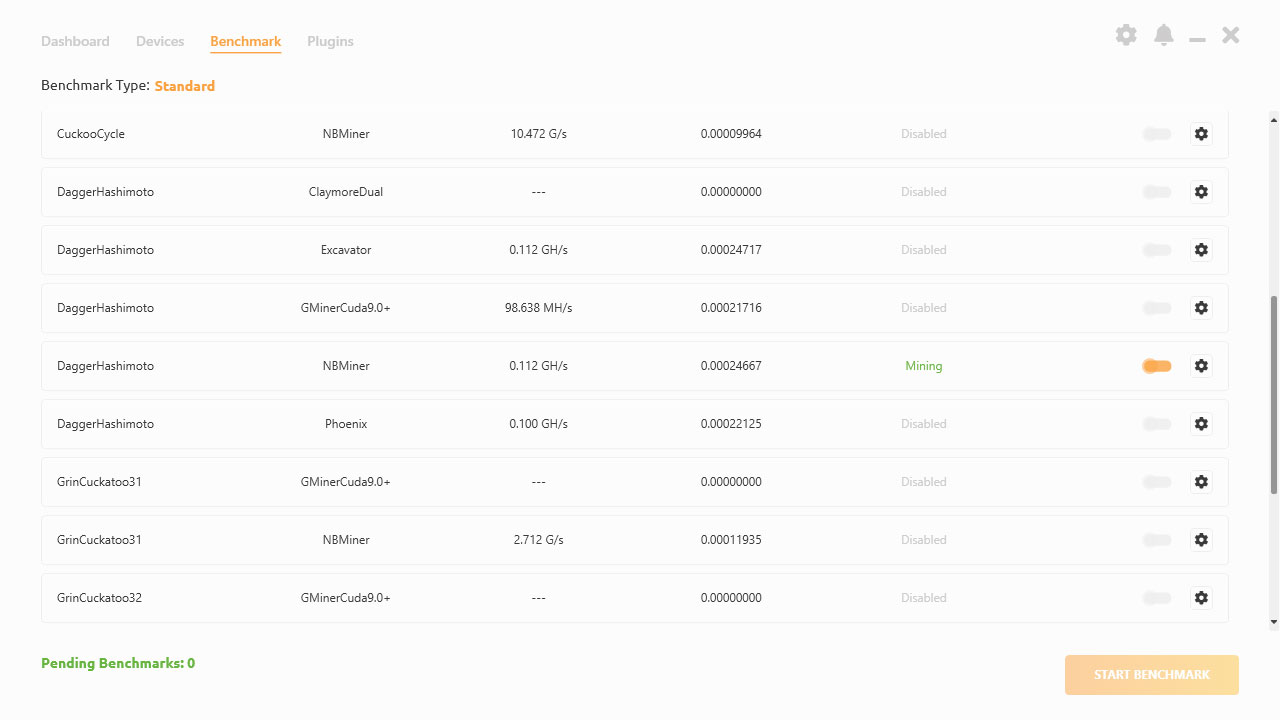
One time launched, the first time information technology runs, NiceHash Miner volition benchmark your hardware using various common mining (hashing) algorithms. Which algorithms and software get tested varies a scrap by your GPU, and you can customize things quite a bit. Right now, DaggerHashimoto (aka, Ethash, what Ethereum uses — a modified variant of DaggerHashimoto) tends to exist the nearly profitable, though sometimes Octopus, Kawpow, or some other algorithm might climb to the top.
The thought is that NiceHash Miner volition cull whatever is currently the nigh profitable money to mine, based on what people are willing to pay to hire your hardware. Sometimes a new coin volition launch, or someone volition want to dedicate a lot of mining power at a specific coin, and they'll pay more than to do so. Instead of mining Ethereum 24/seven, you might occasionally run another algorithm, and information technology's all managed by the software, which normally (but not always) manages to do a expert job.
The initial benchmarks on NiceHash Miner can exist a bit prone to error, unfortunately. That'southward because the tests are only run for a minute each, and equally your GPU heats upwards information technology may also slow downward. That means the first algorithm benchmarked often ends upwards with an inflated result. You can get a better estimate of performance by using the Precise style (on the benchmark tab), which takes twice equally long to criterion. You can too manually enter hash rates, so for example if you notice that after 30 minutes or more than that NBminer stabilizes at 94MH/southward instead of 98MH/s, you can fine tune the mining speed. You tin can too schedule an algorithm for retesting if yous recollect the result is off, and by default (information technology can be turned off) NiceHashMiner will periodically download new versions of the miners and automatically retest.
The third and concluding NiceHash option is to use NiceHash Bone. This is a custom Linux installation that would run in place of Windows, and information technology's recommended for larger scale mining farms that use NiceHash. As with all things Linux, getting it upwardly and running may crave a bit more cognition and patience, only considering it'southward an OS tuned specifically for mining, hash rates tin can be higher. (We didn't practice any of our testing with NiceHash Os, due to time constraints.)
In that location are two big downsides to mining via NiceHash. One is that you're not actually getting Ethereum — non directly, at least. You'll get paid in Bitcoin, which you tin and then merchandise for Ethereum if yous desire. That'due south not necessarily a bad thing, because BTC is the largest of cryptocoins, but if you want ETH you'll need to accept some extra steps. The other downside is that NiceHash takes a cut of the amount paid, and the net result is generally lower payouts than mining Ethereum yourself. How big is the deviation? Currently, direct Ethereum mining should pay about 7% more than than NiceHash. That's a pretty big mining fee, though over again the ease of employ with NiceHash is hard to overstate.
How to Mine with a Mining Pool
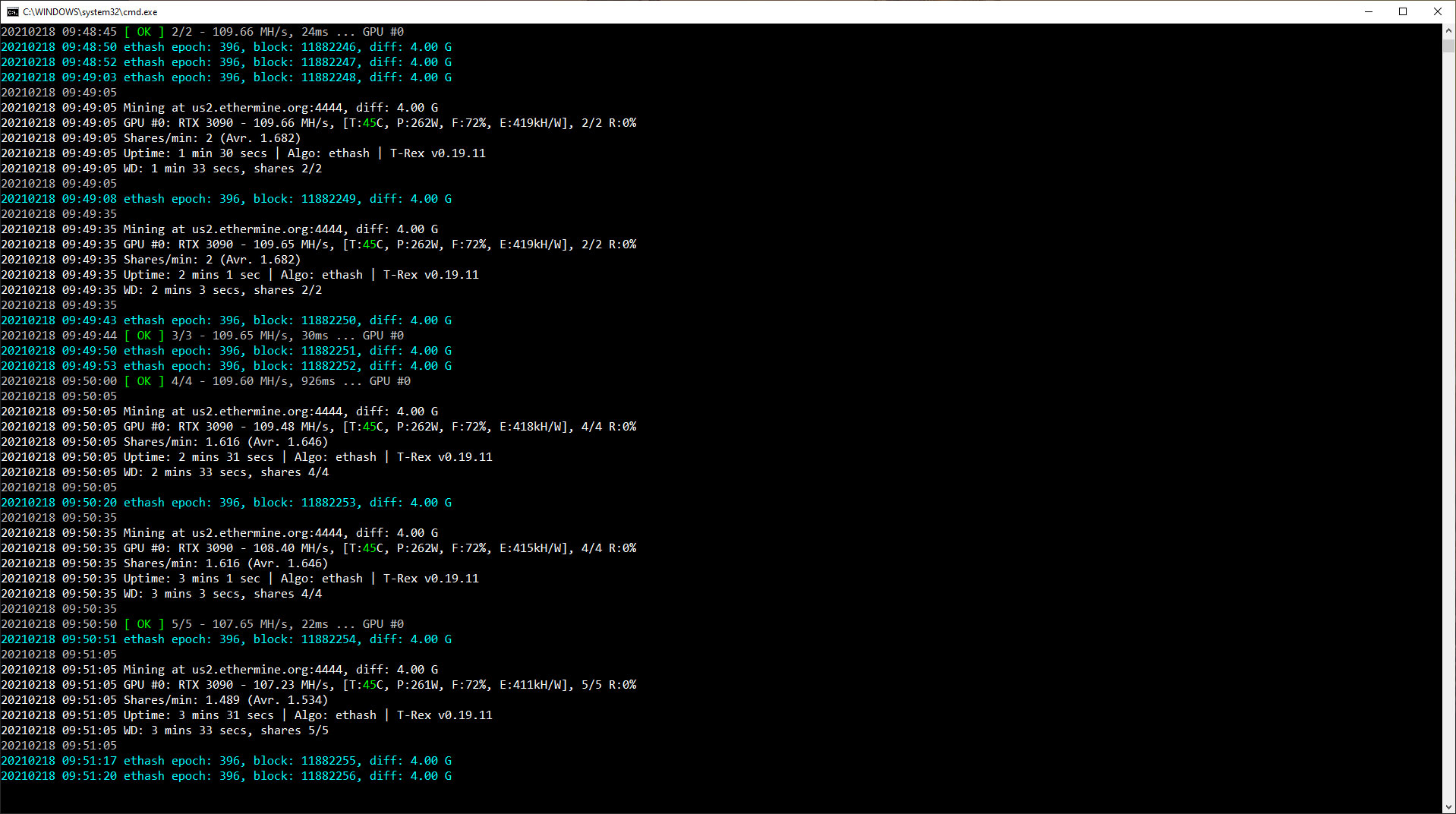
Transitioning over to a mining pool instead of NiceHash opens upwards more than opportunities, to both software and method of payment. Where NiceHash currently only pays out in BTC (again, not necessarily a bad matter), Ethereum mining pools will pay you lot in ETH. There are still fees to pay — well-nigh mining pools take i–2% of the total income — simply that'southward less than the 7% departure in pay that yous might get from NiceHash.
The first selection is what mining pool to use. Generally speaking, yous'll get more than stable income past going with the largest pool, only at that place are various reasons for non doing that. Most of those reasons are donating, like not wanting any one pool to control also much of the total network hash rate, so our advice is to become with a larger pool. (
Google is your friend.) Subsequently choosing a puddle, you'll need to prepare your account, choose which mining software yous desire to run, and then configure your launch settings. That'southward simplifying several steps, all of which can vary quite a bit depending on which puddle you use.
Pool fees are a critical factor, ranging from 0% to 3% or more. Free pools tend to be less reliable, since it costs money to run the servers and infrastructure for a pool, and so it'southward often amend to pay a small fee rather than deal with the potential downtimes. Also pay attention to the payout scheme and payout requirements for the pool. Most pay out your Ethereum daily, provided y'all've hit minimum quotas, but some of those quotas are pretty high. For example, Ethermine.org has configurable payout limits starting at 0.1 ETH, which would have nearly a calendar month to reach with a unmarried GPU — a single RTX 3080 volition mine about 0.006 ETH per day. Information technology also pays out weekly if you hit at least 0.05 ETH and every 14 days if you've accumulated at least 0.01 ETH. The payout schemes meanwhile are designed to discourage puddle hopping (i.e., changing pools if you go a 'difficult' work unit or whatever), though we won't go into the intricacies of the various schemes here.
One big difference betwixt NiceHash and your typical mining pool is that y'all need a separate Ethereum wallet to store your coins — you really don't want to just leave the coins with the pool indefinitely. While information technology'south technically possible to have your coins transferred to somewhere similar Coinbase, it's by and large best not to accept mining pool payouts go directly to a trading platform. We recommend setting up an online wallet, through a service like
MyEtherWallet, and apply that accost for your pool payouts.
PSA: Don't employ the same password on any sites related to cryptocurrency mining. Create a unique countersign on each 1 (consider using LastPass or a like product), and if you lot're planning to concord onto the coins for the long booty, get them into your own wallet.
Once everything is in place, you tin can finally launch your miner. A lot of the miners have sample configurations for popular pools that you can edit, and the pool itself volition have configuration details on how to connect. Then as an case, launching T-rex mining with Ethermine looks like this:
t-rex.exe -a ethash -o stratum+tcp://us2.ethermine.org:4444 -u 0x0b8324FcE71D4E6501b5E82aB9466f230A990cB5 -p ten -west worker1That tells the miner what algorithm to utilize (ethash), the pool server to connect to (Ethermine), the wallet address (put your own address in!), password (none), and worker name. Almost mod miners accept a similar syntax, so tweaking the mining command isn't too complicated. Here's the take hold of: NiceHashMiner has a bunch of extra features to allow remote monitoring, notifications if a miner goes offline, ability to run a script if something appears incorrect, etc. Doing all of that with pool mining requires more time and effort, which is why a lot of people are willing to have a bit less in the manner of coins.
How to Solo Mine

Don't. No, seriously, information technology's not worth the hassle and you almost certainly won't actually get whatever coins — at least not with Ethereum or Bitcoin.
Statistically, your chances of solving a cake are equal to your percent of the full hash rate of the network. With Ethereum, the current network hash rate is now over 1 PH/s, or ane billion MH/southward. Even if you had a farm of 100 RTX 3080 GPUs each doing 95MH/s, that'southward only 0.0009% of the total. Mathematically, Ethereum averages around 6500 blocks per day, so your odds would exist about 6% per day of finding a block, with an 86% chance of striking a block in about a month. With a single RTX 3080, your odds of hitting a single cake in a twelvemonth are only xx%, and 49% subsequently three years. The proof of stake transition makes any such talk completely irrelevant. In practice, the mining pools accept a much higher chance of solving and getting credited with a block.
How much is a single block worth? At that place's a static block reward of two ETH correct now, plus transaction fees that currently average around 2 ETH, plus some 'uncle' rewards that are relatively pocket-sized by comparison. Basically, 3.5 ETH, plus or minus a few percent. At a price of roughly $2,800 per ETH (at the time of writing), that'southward quite a fleck of value, but information technology just works if you actually solve a block. For all but the most defended of mining operations, the steady payouts that come from joining a mining pool are a far safer approach.
But let's say you lot still want to try solo mining. What do you demand to exercise? Beginning, you lot have to gear up an Ethereum wallet and download the Ethereum blockchain. Fifty-fifty after pruning a bunch of extra information that you don't demand, information technology'due south yet typically around 525GB in size, and downloading can accept quite a while. Once your wallet is synced up, you can point your own mining rigs at your local node, which is mostly the same equally configuring miners for a mining pool except now yous're using your own puddle. Congratulations! You're now flying solo.
Even with a lot of high-stop GPUs, you likely won't mine whatever Ethereum earlier proof of work mining ends. The theoretical benefit to solo mining is that you become the whole cake reward plus fees, with no percentage going to the pool. The downside is that without a massive farm, you'll very likely end upward getting goose egg.
There are however mining pools that operate on a 'solo' mining approach. Basically, the whole pool works together to observe a block solution, which ways it's more probable to go incorporated as the 'winning' block, only but the participant (mining address) with the highest contributions to date (since the last credited block) gets the reward. This is much easier to apply than pure solo mining, but without a decent amount of hashing power information technology will take quite some time to reach the point where you become the rewards from mining a block. Besides, you still end up paying a small pool fee, normally 1%, at which indicate you should probably just go back to a mining pool with steady payouts.
Historical Ethereum Pricing, Difficulty, and Profits
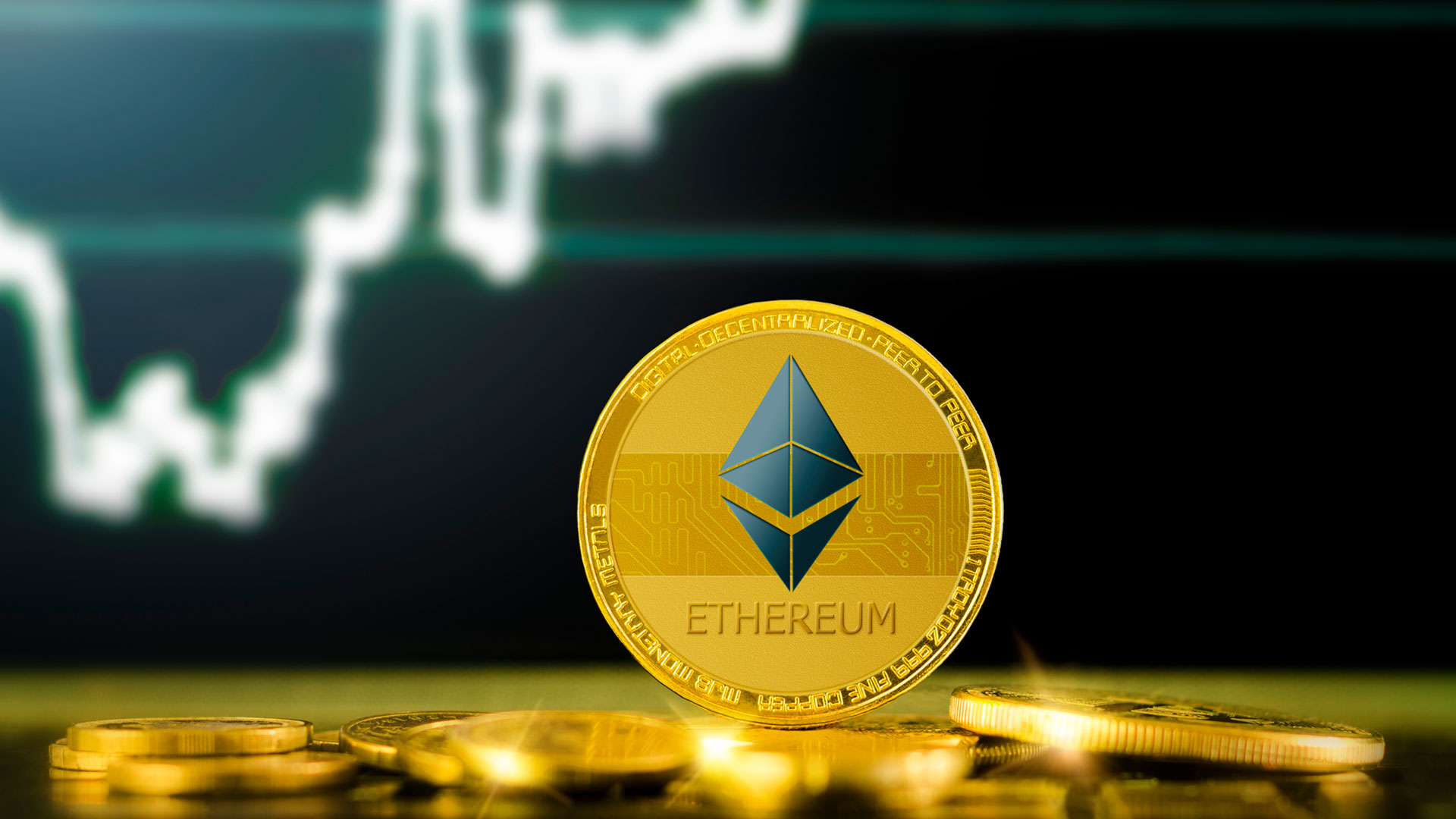
That covers how to get started, simply nosotros're far from washed. With the above information, you can now burn down up your PC and begin mining. That'southward the good news. The bad news is that actual long-term profitability is far less clear cut. The existent difficulty is predicting where cryptocurrency will get next. Both Bitcoin and Ethereum are downwardly significantly from their highest always valuations, just there's still a lot of up and downwardly movement. Maybe it will bounce back, perhaps it was a bubble. Who'south correct? Depending on when you expect, you'll find ample data-driven support for just about whatsoever opinion.
The most of import matter to keep in mind is that cryptocurrencies are volatile. Information technology doesn't matter if you're treating them similar a commodity and twenty-four hours trading, or mining, or running a mining pool. Things are in a constant land of flux. Just look at the cost of Ethereum since information technology launched back in 2015. (Note: The following charts were final updated in March, but the patterns outlined hither accept continued.)
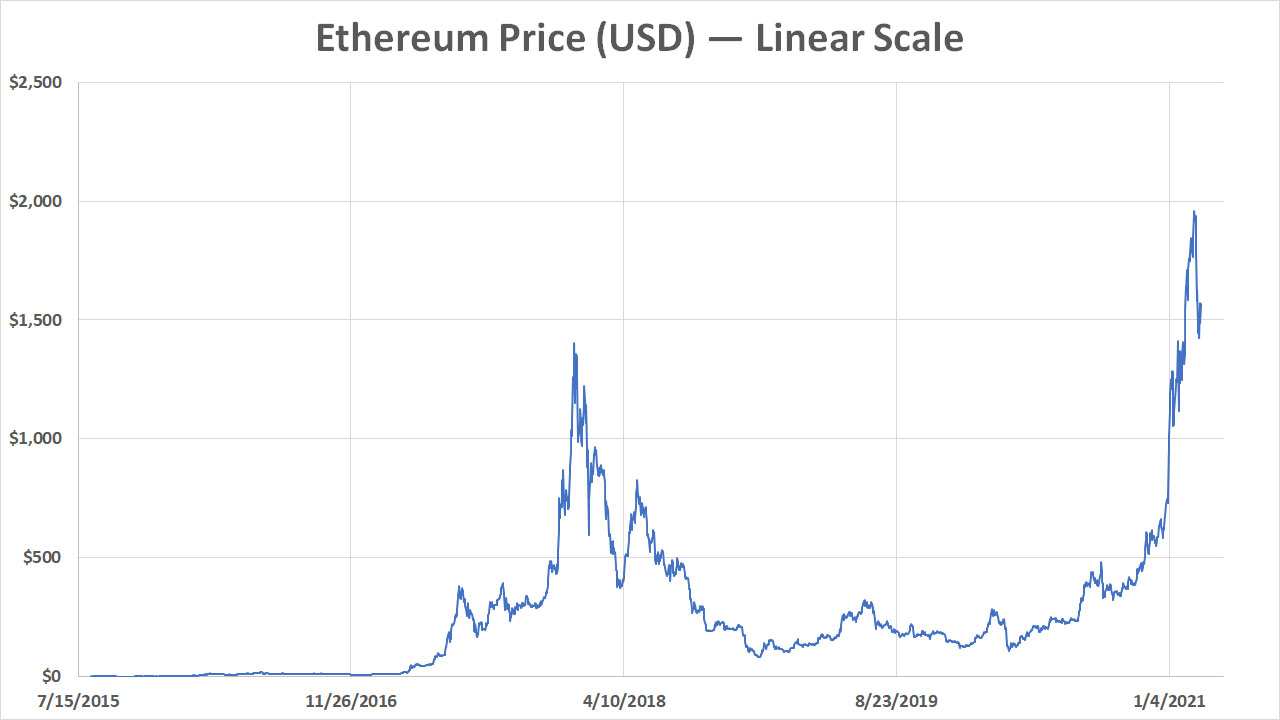
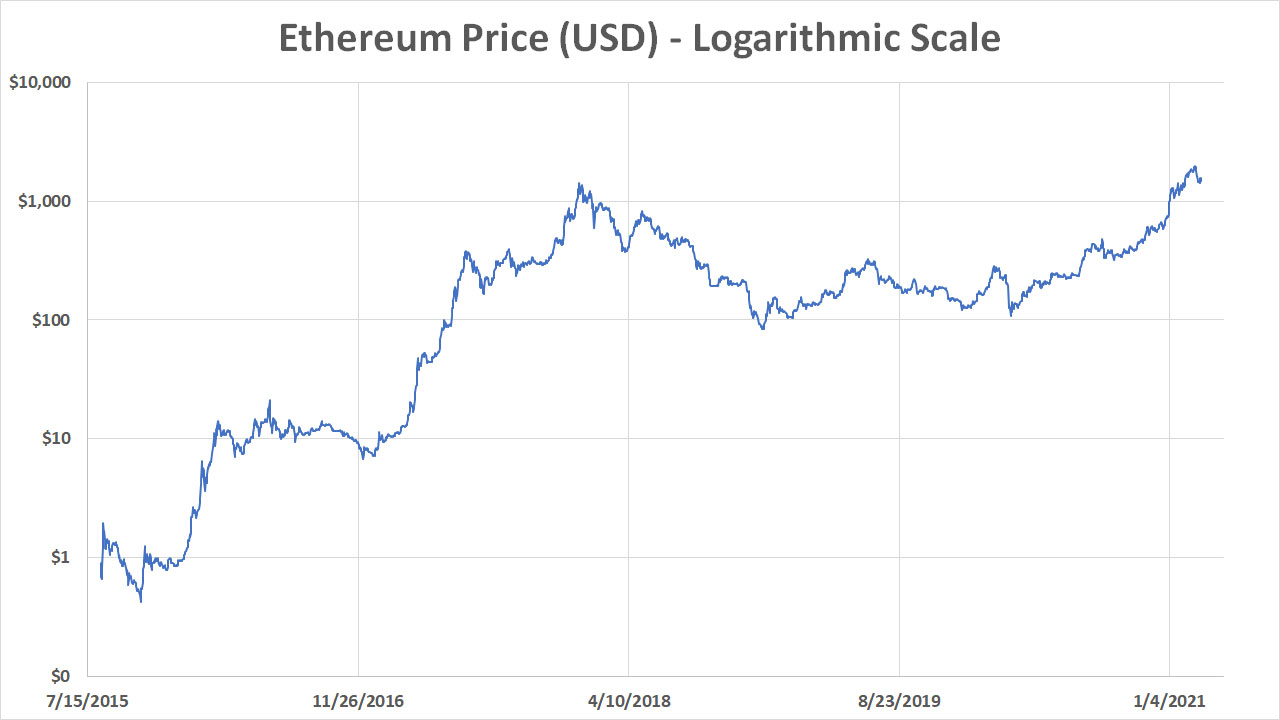
We've got the linear nautical chart, which includes an astonishing spike at the right edge (early 2021). That spike looks very like to the one that occurred in 2017, naturally, and we should maybe just ignore the equally dramatic crash in 2018 — or that's what the optimistic miners seem to think.
The logarithmic nautical chart doesn't look well-nigh as impressive, and it's clear the real winners with Ethereum are the people who got in back in 2015, or even 2016. Incidentally, most two thirds of all Ethereum was actually part of a 'pre-mine' that went to 'investors' before mining was even possible. Everyone joining the bandwagon now conspicuously missed the best part of the ride. Alternatively, there's enough of room left for future growth and spikes, merely that's but speculation.
We've passed elevation profitability for mining Ethereum, at least for the fourth dimension beingness. That'southward where the HODL (agree) mentality comes into play. Mining for $10–$17 per day on a graphics card that costs $i,000–$one,750 might non seem like a bad idea. Mining at $five per mean solar day is less enticing, and $2 per day or less looks pretty atrocious. And yet, from August 2018 up until July 2020, Ethereum mining with 100MH/due south would take netted less than $two per day.
At that place'south another fashion to look at Ethereum mining. If you threw 100MH/south at Ethereum dorsum in 2015, by the cease of the twelvemonth, you'd have around 854 Ether, which was worth about $803 at the time. In 2016, y'all would have accrued an additional 487 Ether — twice the time mined, a bit more than half the rewards. Of class, the price went upwards a off-white amount in 2016, so your accumulated one,341 Ether would have been worth over $11,000.
From 2017 up until today, mining has been far less compelling, and it's becoming increasingly and then. Over three years of continuous mining at 100MH/south would have just generated 51 Ether. Certain, that's now worth over $100,000, but the early adopters made the big gains. If you got in at the showtime and mined while property (and merely swallowed the power and equipment costs), your ETH would be worth over $3.75 one thousand thousand.
The point is that you either got in early and made large gains, or you're hoping that things will continue to go up. And if that's your conventionalities, why not merely invest in Ethereum directly rather than trying to build a mining farm?
What Settings Are 'Safe' for 24/7 GPU Mining?
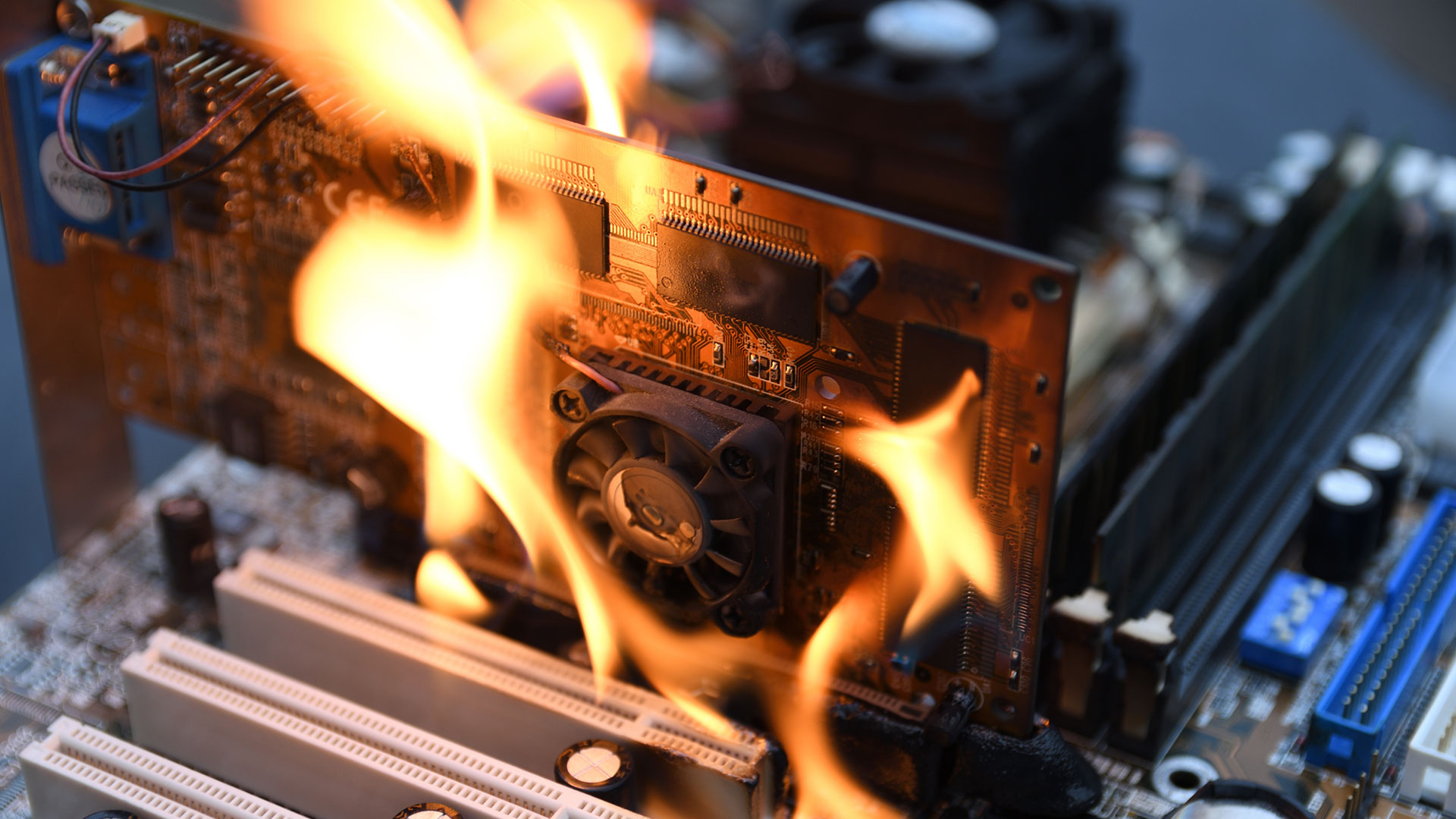
Do a quick search for the optimal mining settings on a particular GPU and y'all're certain to find a agglomeration of diverging opinions. Some will throw caution to the current of air and look to maximize hash rates in pursuit of short-term gains. Let'southward exist clear: These people are very likely to end upward with failed hardware. AMD and Nvidia GPUs are tuned somewhat conservatively, with the intent to allow for many hours of gaming, every day, for several years. Button the clocks, fan speeds, and temperatures higher and run them 24/7 in a cryptocoin mining subcontract and we tin can guarantee you'll experience component failures at some betoken. At that place's a reason
Nvidia'due south CMP cards (Cryptocurrency Mining Processors)target lower hash rates than the consumer Ampere GPUs currently evangelize. Striking a balance between raw performance, efficiency, and profits is key.
The difficulty is that what works well on i GPU, and even on 1 item card using a specific GPU, may not work everywhere. Information technology's the aforementioned onetime silicon lottery story we see with CPUs, GPUs, and retentiveness. Parts are binned, but some higher quality parts inevitably slip into lower tier products on occasion, and yous can almost always get at least 5% more than performance (compared to stock) out of any graphics carte. 10% might also exist possible, but beyond that you're basically redlining your carte du jour — meaning, you're pushing well into dangerous territory and your engine might seize up.
We have a whole article about
tuning GPUs for optimal Ethereum mining operation, but even that doesn't cover every possibility. Allow's discuss things a flake more than hither, as presumably some of the people reading this are new to mining and GPUs in general and may be led off-target by claims fabricated on mining forums. Our advice: Be more cautious and don't hunt every final megahash.
First, yous demand to know what GPU yous're using. We use code names a lot, so here'due south the quick rundown. For Nvidia, Ampere GPUs are establish in RTX xxx-series cards, Turing GPUs are in RTX 20-series and GTX 16-series cards, and Pascal GPUs are in GTX 10-serial GPUs. For AMD, RDNA2 GPUs are used in RX 6000-series, and RDNA1 are used in RX 5000-serial (both families are called Navi, but the 5000-serial GPUs are Navi 1x and the 6000-series GPUs are Navi 2x); Vega GPUs are in Radeon VII, Vega 64, and Vega 56; and Polaris GPUs are in the RX 500-series and RX 400-serial parts. Each family has different features.
Temperatures and Fan Speeds
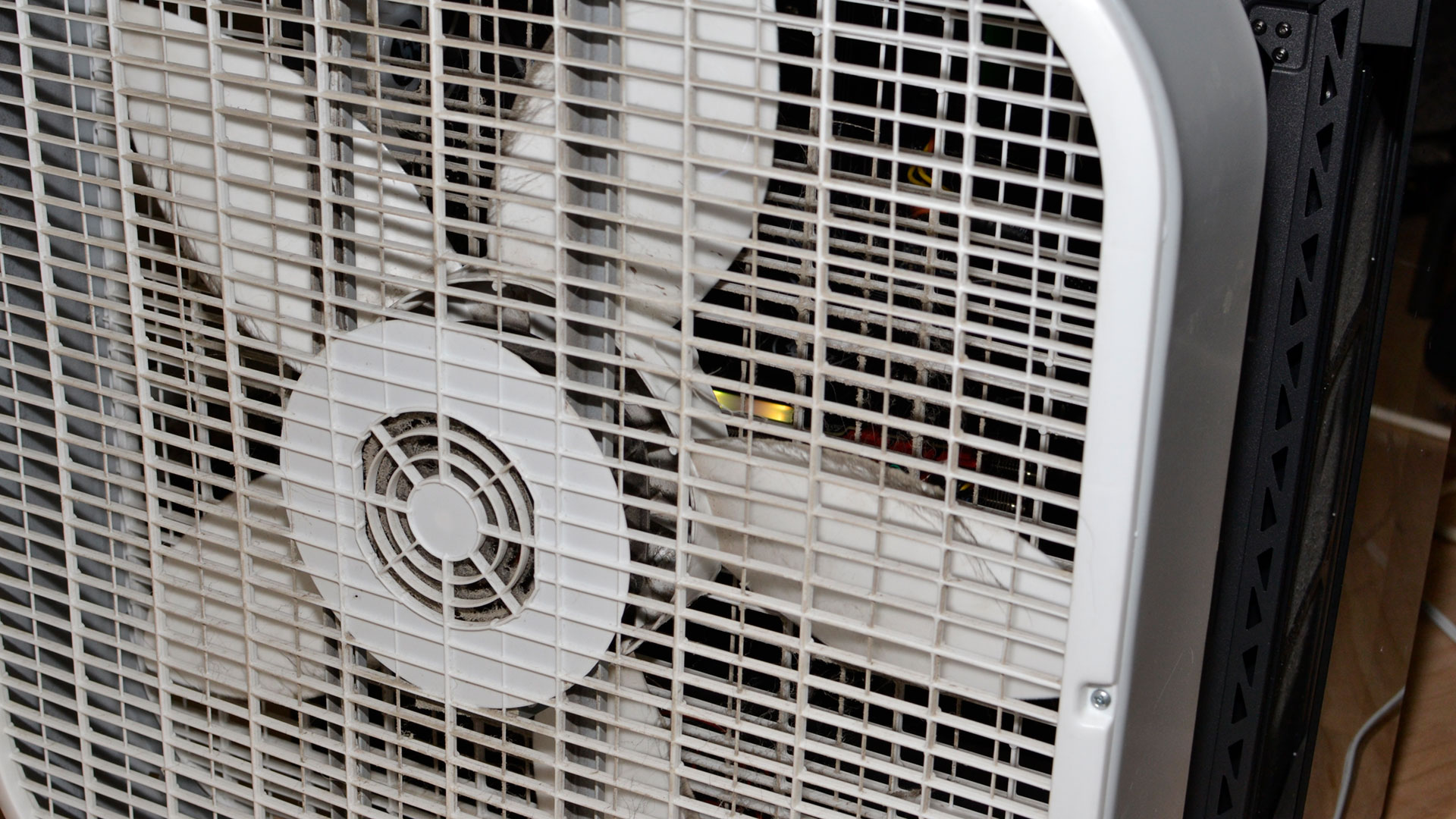
Temperatures — for all components, not merely the GPU core — and fan speeds are a practiced indicator of what'due south safe for long-term apply, so let'southward beginning there. A lot depends on the specific carte du jour and fan design, but consumer GPU fans absolutely are not designed to run at eighty-100% fan speed and 90-100C temperatures for abiding 24/vii use. In fact, on many GPUs the maximum fan speed is commonly limited to around 50%. Nvidia's 3090 and 3080 Founders Edition cards won't go in a higher place that mark until / unless things go really bad, like super hot GDDR6X temperatures. AMD'due south Vega cards prefer fifty-fifty lower fan speeds, because no i wants a horribly loud leaf blower while gaming.
With gaming GPUs, the expectation is that cards are only used at most perhaps 12 hours per day. And then going from 12 hours per day at xl-50% fan speed to 24 hours per day at 80-100% fan speed means the fans will wearable out much sooner. A really loftier-quality fan might final ane-2 years or more; we've had fans in the past burn out in less than vi months. Rather than cranking up graphics card fan speeds, an alternate solution is to merely get a big and cheap box fan and aim it at your PC. They toll about $xx, which is less expensive than replacing fans on your graphics card, simply yous'll definitely need to grit regularly if you go that route.
If you want a reasonable estimate of where a card should run its fans, turn off the overclock and run a game at 1440p ultra settings and just permit it run for fifteen–20 minutes, and then check temperatures, fan speeds, clocks, etc. Alternatively, use FurMark's 1600x900 stress test, though exist warned that sometimes FurMark volition heavily throttle the GPU clocks to keep temperatures and fan speeds in bank check, and so sometimes it'south really less demanding than running a game. Either mode, the maximum fan speed you come across in this scenario is where the manufacturer thinks the carte should last 3+ years. Anything above that and you're more likely to have the fans at least fail.
Next, temperatures. Most modern GPUs volition take pretty reasonable temperatures on the bodily graphics chip, particularly if you follow the communication in our
Ethereum optimization guide, but that'due south non the only critical factor. Memory and VRM (Voltage Regulator Module) temperatures are also factors, only not all GPUs or graphics cards report these items. That makes information technology a chip trickier to determine what's 'rubber' and what might cause premature component failure.
We'll get into the clocks and speeds momentarily, but we think your all-time long-term bet is to allow GPU temperatures hit at virtually 70C, preferably less. VRM temperatures should be kept to a maximum of 90C (once more, preferably less), and we definitely wouldn't run with GDDR6X temperatures of more than 100C and expect a card to remain viable for ii years. Maybe that's pessimistic, only we've had graphics cards neglect far faster than that in the past, and so better safe than sorry is our motto. For GDDR6, aim even lower, like maybe 85C (if your card even reports GDDR6 temps).
If you're using Ampere (RTX 30-series), the 3070 Ti, 3080, 3080 Ti, and 3090 use GDDR6X, and HWiNFO64 can report the retentiveness junction temp. Again, we retrieve if information technology's above 100C, that's too hot for long-term reliability. It might concluding a twelvemonth or more than at 106C, or it might terminal six months — it's tough to say. The RTX 3070/3060 Ti/3060/3050 use standard GDDR6 and the retention temperatures should exist quite a bit lower, only nosotros don't know how much lower because these cards don't report GDDR6 temps. AMD'southward RX 5000/6000 series cards utilise GDDR6 and report temps via HWiNFO, and could hit 90C at stock, simply after tuning for optimal operation they run at around 65–70C in our testing.
Simply put, GPU components (fans, VRMs, memory, capacitors, etc.) can and will wear out. Some of us did a lot of mining dorsum around 2013/2014, and helped other people besides, and nosotros damaged or outright killed quite a few cards by being too aggressive. Some totally failed and some were only very unstable. Nearly all of them had fans go bad, and RMAs were a complete pain. It took 4-6 weeks to get a bill of fare dorsum, and some manufacturers even refused warranty service "due to physical harm" or other such claims. The manufacturers are going to meet higher RMA rates with some other mining blast, and some will utilize any reason to deny a claim that they can detect. #Experience
GPU and Retentivity Overclocking
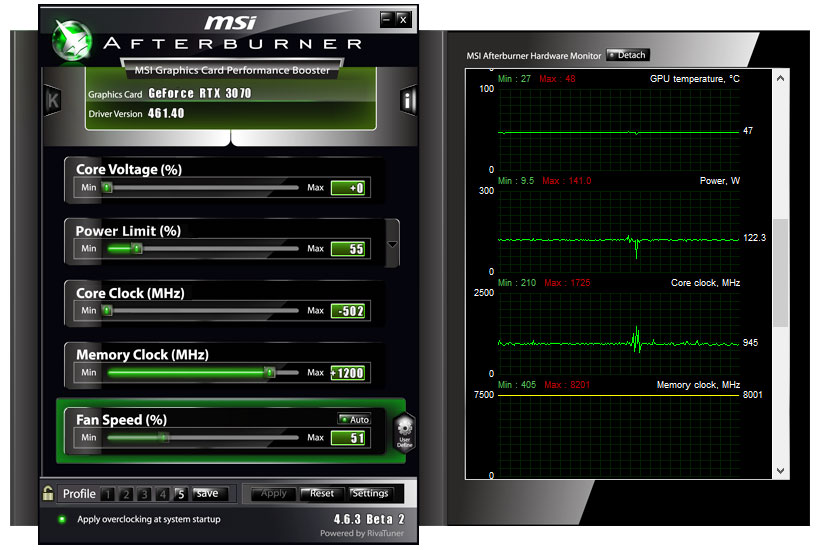
Now that we've talked well-nigh temperatures and fan speeds, allow's talk about overclocking — or even underclocking and undervolting. Retention speed is a key factor in Ethereum mining performance. While tuning retention clocks, y'all want to pay attending to long-term hash rates. Sometimes, you might bump the retentivity speed by 5% or more and only meet a tiny comeback in hash rate, which means something else (probably GPU clocks or performance) is holding you back. Alternatively, yous may notice (for case on the Ampere, Turing, and Navi GPU families) that GPU clocks by default run much higher than needed. An RTX 3080 with memory running at 20Gbps and a 1.9GHz core clock will get about 95MH/s while using around 320W of ability. Drop the GPU clocks to 1.4GHz and limit the power to 230W and you'll still become nearly 95MH/s — all of the actress GPU clocks and power are wasted, as the memory speed is the limiting gene.
Beyond pure retentiveness speed, Nvidia's Ampere GPUs accept EDR technology on the GDDR6 — that stands for Fault Detection and Retry. If the GDDR6 gets an fault simply 1-2% of the fourth dimension, it tin be detected and the GPU just asks for the data again and usually gets it without an error. This ways y'all can hit higher clocks that aren't unstable, but memory performance actually degrades by a sure point. If you're getting errors caused by memory overclocking on an Ampere GPU, it means you've pushed well across the stable limit and nosotros'd back information technology off at least 10%.
Trying to balance retentiveness clocks confronting power and temperature is circuitous, and it'southward definitely possible to find 'stable' clocks that will end upwards causing problems down the road. One reasonable approach is to find the maximum stable retentivity overclock, by bumping the clock speed up in 50–100MHz increments and letting the mining run, until you go errors or a system crash. Once that happens, drop the OC by 10–twenty% and yous should be reasonably condom. Then as an case, if you can hit a 1000MHz retentivity OC, nosotros wouldn't run at more than 900MHz, and 800MHz is probably a better idea for long term use.
As well overclocking of the memory, you should look into underclocking and undervolting of the GPU, particularly for AMD'due south previous-generation cards. The Vega and Polaris families are very power hungry at default settings, and it's often possible to drop the voltage by 0.2–0.3V. That's a huge divergence, especially since ability scales with the square of the voltage. You lot'll probably need to reduce maximum clocks while reducing the voltage, but the dramatic boost in efficiency makes the effort worthwhile. If you lot feel crashes or instability, you'll need to tweak the voltages and/or clocks more than.
Putting It All Together

Ultimately, the goal of miners is to maximize profits, taking all things into consideration. That means balancing the cost of the hardware, retentivity speeds, GPU clocks, pool mining fees (or NiceHash fees), ability consumption, time required to manage the mining PC(southward), the cost to service or replace hardware, and more. Figuring out the optimal residue between all of those factors is circuitous, and while it might seem tempting to chase after every concluding bit of hashing functioning, that may not be the best long-term solution.
For case, tuning for an extra 5% more hashrate just isn't worth it if it means going from l% to an lxxx% fan speed. If you lot're building a larger mining farm (again, not something nosotros recommend for a multifariousness of reasons), efficiency will be a height priority. The RTX 3090 and RTX 3080 might be the fastest GPUs for mining, but from an efficiency and price perspective, RTX 3060 Ti might exist a meliorate choice. Two 3060 Ti cards for example will basically friction match a unmarried RTX 3090 while using less than one-half equally much power. But permit's take things a pace farther.
A mining subcontract with a 400 Amp limit (48kW) could run effectually 150 RTX 3090 GPUs, using six GPUs per PC with simply 25 PCs total, and would be capable of around 17.2GH/s. Alternatively, in the same ability limit, dropping down to RTX 3080 GPUs would allow for approximately 192 RTX 3080 GPUs spread across 32 PCs, generating around 18GH/south of hashing power (for Ethereum). Finally, using RTX 3060 Ti, it would exist possible to install nearly 60 PCs with half-dozen GPUs each, with an output of virtually 21.6GH/s. (That's just a crude estimate and does not include AC or other items that potentially need power.)
But what would those mining farms cost? Nosotros've put together a rough estimate of hardware costs per PC. That includes an 80 Plus Platinum PSU (ii for the 3080/3090 builds), PCIe riser adapters, fans, a bones CPU, a motherboard with at least vi PCIe slots, 16GB memory, and SSD storage. Plus all the GPUs, naturally, at
electric current eBay prices. Without the GPUs, the price per PC is around $760 for the RTX 3060 Ti builds (ane PSU) and $1,015 per PC for the 3080/3090 builds (two PSUs). Median prices at eBay on the 3060 Ti are currently $925, $i,600 for the 3080, and $2,600 for the 3090.
That gives a full cost of $6,310 for each mining PC using RTX 3060 Ti cards (assuming yous can even acquire enough of them), $ten,615 for the 3080 PC, and $xvi,615 for the 3090 build. Yes, that's a ton of money. You can get nigh 360MH/s from the 3060 Ti PC, 570MH/s from the 3080 build, and 690MH/s from the 3090 PC. Power estimates based on our testing indicate the 3060 Ti PC would apply nearly 800W, including PSU inefficiency and the residue of the PC, while the 3080 would demand effectually 1500W and the 3090 would swallow 1900W.
Based on those prices, ability use, and hash rates, we tin determine approximate break-even time (not including rental space or Air-conditioning). The 3090 PCs would currently net about $22.20 per day, so it would accept ~748 days to break even — assuming aught changes with Ethereum prices or difficulty, which is apparently not going to be correct. The RTX 3080 PC would net around $18.50 per day, requiring ~574 days to break even. Finally, the RTX 3060 Ti build would cyberspace approximately $12 per day and require ~526 days to intermission even.
Hopefully, that explains how far things have fallen. Factor in the warehouse infinite to adapt all those PCs, power distribution, and paying someone (even yourself) to build and maintain all the mining PCs would also be necessary. If you're doing a bunch of mining rigs, you'd be using a lot of electricity, and power use would probably exist 50% higher than the pure PC power employ one time you factor in It infrastructure and cooling. Those would add to the cost, pushing back the suspension even point, and if things accept a change for the worse (equally they did in 2014 and 2018), the whole operation comes crashing down.
Don't Forget Nvidia'southward LHR Limiter
If all of that weren't already bad enough (for miners), Nvidia also updated all of its Ampere GPUs with LHR limiters — Lite Hash Charge per unit. Basically, LHR models are the primary type of RTX 30-series cards you lot'll now find, and hash rates can be cut past fifty% relative to the original models. Non-LHR cards cost more, simply would probably be worth the premium if you're serious most mining. Note that the RTX 3090 does not have an LHR variant, but of course the cost of those cards is already prohibitively loftier and other models are a better choice.
AMD for its function has done nothing to directly curb mining performance or profitability. The RDNA2 architecture relies on a large Infinity Cache to heave gaming functioning, and that doesn't really aid much with mining performance, so even the RX 6900 XT as an example simply gets about the same mining performance every bit a (non-LHR) RTX 3070/3060 Ti.
Besides, annotation that the LHR limiter merely affects Ethereum mining. That'due south going to cease in the coming months regardless, and information technology'southward possible another coin (more probable coins) will take Ethereum's identify every bit the best pick for GPU mining. Note that right at present, even so, the best non-ETH coins tend to generate about half as much value per day.
The Ability of Mining

Bottom line: We're non big fans of large cryptocoin mining farms. There are arguably worse ways to utilise power and money, but in that location are also a lot of better means — ways that don't carry nearly the volatility and adventure of money mining. Never mind the fact that procuring all of the necessary equipment takes time and a lot of coin, or that it makes it difficult for PC enthusiasts to upgrade their PCs. The bigger issue, by far, is that it's putting a ton of computing power to the task of merely securing the blockchain.
Best-case, using the virtually efficient hardware, the Ethereum network would currently employ over a billion watts of power, and Bitcoin would employ over 5.five billion watts — but information technology'due south actually a lot more in both cases, equally a large chunk of the hashing isn't done by the absolute most efficient hardware.
Digiconomist pegs the current power utiliseof the Ethereum network at around 110 TWh per yr, and 260 kWh per transaction. Basically, Ethereum hashing uses 300 GWh every day, which would cost effectually $30 1000000. There's $26 in power costs (using $0.ten per kWh) just to send Ethereum from ane wallet to another. Information technology offsets those costs by minting (creating) about $35 million in new Ethereum coins per twenty-four hours (at current rates).
Ethereum aims to 'solve' all of these bug by switching from proof of piece of work to proof of stake in the coming months. That's great for ability consumption, merely it remains to be seen whether Ethereum will continue to be popular once mining stops, and there will still be enough of other alternative coins that still use proof of work.
Looking at all the costs and power going into these networks, it'due south difficult to remain optimistic virtually their long-term potential. We're strip-mining digital coins, basically, and that's unsustainable. At some betoken, this all hits a plateau, and short of zero point energy or some future technology that allows for clean ability far beyond what we currently employ, in that location'southward a very adept run a risk the viability of mining eventually stops. Maybe that's not this twelvemonth or next yr, but the growth in hash rates, power use, and prices obviously can't go up indefinitely, and it won't. Cryptocurrency networks are designed to discover a 'stable' equilibrium, which effectively means getting enough people to believe in and apply the money to brand it feasible. Equilibrium most certainly isn't going to be highly assisting.
Do yous still want to mine? That's your choice. We've provided the information here that allows you to get started. We've also provided a realistic view of what to expect, then hopefully you fully understand the risks. TL;DR: Don't bet the farm or your retirement on PC hardware and upgrades solely used in pursuit of mining. We also recommend mining at conservative settings until you've at least paid for the hardware y'all bought, which could take over 2 years. We'll see how long this crazy cryptocurrency ride remains viable, simply don't exist surprised if that'south not about as long equally you'd demand to turn a good for you profit, as that ship probable already sailed.
Source: https://www.tomshardware.com/how-to/mine-ethereum-nicehash-mining-pools-optimal-settings
0 Response to "How Do You Know if Youre Mining Ethereum"
إرسال تعليق